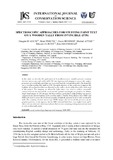Spectroscopic approaches for studying faint text on a wooden tally from Invincible (1758)
Metadata
Show full item recordAuthor
Goltz, Douglas M.
Piniuta, Brent
Huebner, Erwin
Attas, Michael
Cloutis, Edward
Broomhead, John
Date
2013-01-01Citation
Goltz, D.M., B. Piniuta, E. Huebner, M. Attas, E. Cloutis, and J. Broomhead. "Spectroscopic approaches for studying faint text on a wooden tally from Invincible (1758)." International Journal of Conservation Science 4 (2013): 3-12.
Abstract
In this study we describe the application of X-ray fluorescence, variable pressure scanning electron microscopy and visible (420-720 nm) hyperspectral imaging to assess the surface properties of a wood tally stick that was recovered from the 3rd rate Invincible. The Invincible was a wooden warship that sunk in 1758. The main objective of this work was to improve the legibility of very faint text that was detected on the surface of one of the three tally sticks used in this project. For imaging, an ultraviolet light source was used to achieve reasonable contrast between the text and the wood and the optimal wavelength was found to be 365nm. Single band images at 550 nm gave the best contrast, particularly if flat fielding was used to compensate for uneven lighting of the wooden surface. Finally, X-ray fluorescence (XRF) and SEM were used to assess the wood and possibly identify the material used to write on the tally stick. The scanning electron microscopy (SEM) images did not reveal the presence of any graphite particles or ink deposits, but the XRF indicated that there were higher levels of Fe where text was detected, which may indicate that an iron containing writing material was used to write on these tally sticks.

